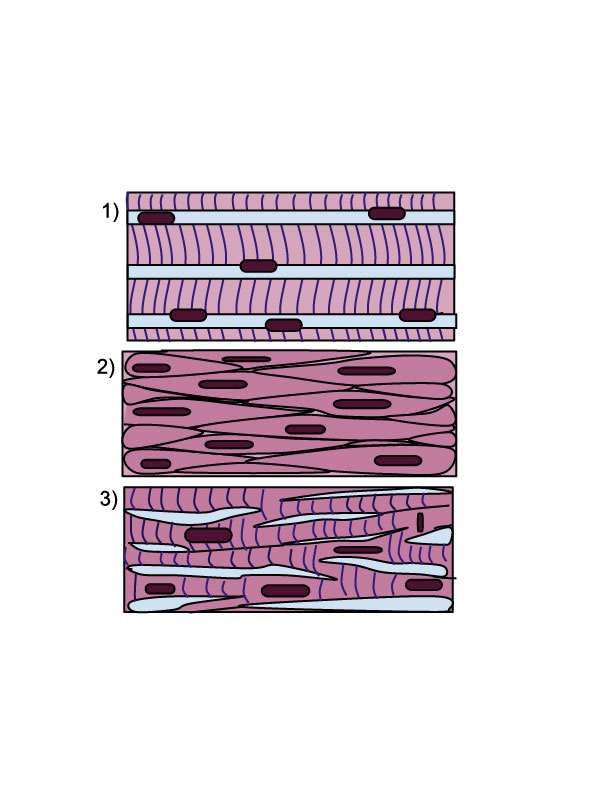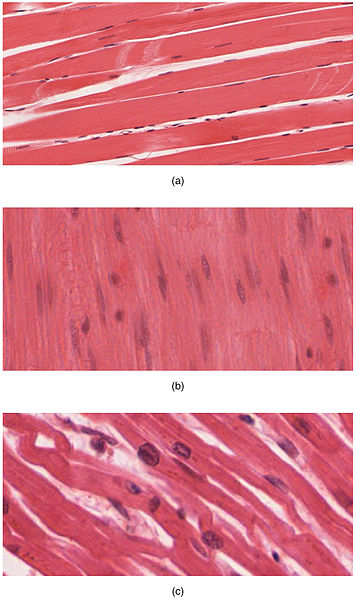MUSCLES-STRUCTURE AND FUNCTION
TYPES OF MUSCLE TISSUE
There are three types of muscle tissues in the body: skeletal muscle, cardiac muscle, and smooth muscle. Let's discuss each in turn.
Skeletal Muscle
Skeletal muscle is also known as voluntary muscle because we can consciously, or voluntarily, control it in response to input by nerve cells. Skeletal muscle, along with cardiac muscle, is also referred to as striated ("striped") because it has a microscopically streaked or striped appearance. Skeletal muscle and its associated connective tissue comprise about 40% of our weight. You may want to write the following words onto your pillowcase: skeletal, striated, and voluntary. Perhaps doing so will permanently link these three words in your mind. More likely, however, is that your landlord will make you replace your pillowcase.

Title: File:Muscle Tissue (1).svg; Author: Mdunninig13; Site: https://commons.wikimedia.org/wiki/File:Muscle_Tissue_%281%29.svg; License: This file is licensed under the Creative Commons Attribution-Share Alike 3.0 Unported license.

Title: File:414 Skeletal Smooth Cardiac.jpg; Author: OpenStax College; Site: https://commons.wikimedia.org/wiki/File:414_Skeletal_Smooth_Cardiac.jpg; License: This file is licensed under the Creative Commons Attribution 3.0 Unported license.
Cardiac Muscle
Cardiac muscle is only found in the heart, and although it is striated like skeletal muscle, it functions involuntarily. Cardiac and most smooth muscles are autorhythmic-they are capable of contracting spontaneously without nervous or hormonal stimulation. The heart contracts or beats about 100,000 times per day, 36 million times per year, and about 2.5 billion times over the course of a life. In just one day our blood travels about 12,000 miles-four times the distance across the US from coast to coast-and over the course of our lives, our heart pumps about 3 super tankers full of blood. Dont strain your brain trying to memorize these numbers. The goal is to appreciate the abilities of this incredible organ. You may want to write these words on the other side of your pillowcase: cardiac, striated, and involuntary. No harm done now-you've already ruined your pillowcase anyway.
Smooth Muscle
Smooth muscle is widely distributed throughout the body, being found in the walls of hollow organs such as our digestive, reproductive, and urinary tracts, tubes such as blood vessels and airways, and in other locations, such as the inside of the eye. It gets its name because it lacks the striped appearance that skeletal and cardiac muscle display microscopically. Along with cardiac muscle, smooth muscle is involuntary-not under our conscious control. Smooth muscle is sometimes known as visceral muscle because it is a major component of many internal (visceral) organs. You may want to borrow your roommate's pillow and write visceral, nonstriated, and involuntary on it. Your roommate will despise you, but it may help you remember smooth muscle. You can always get a new roommate.
**You may use the buttons below to go to the next or previous reading in this Module**


